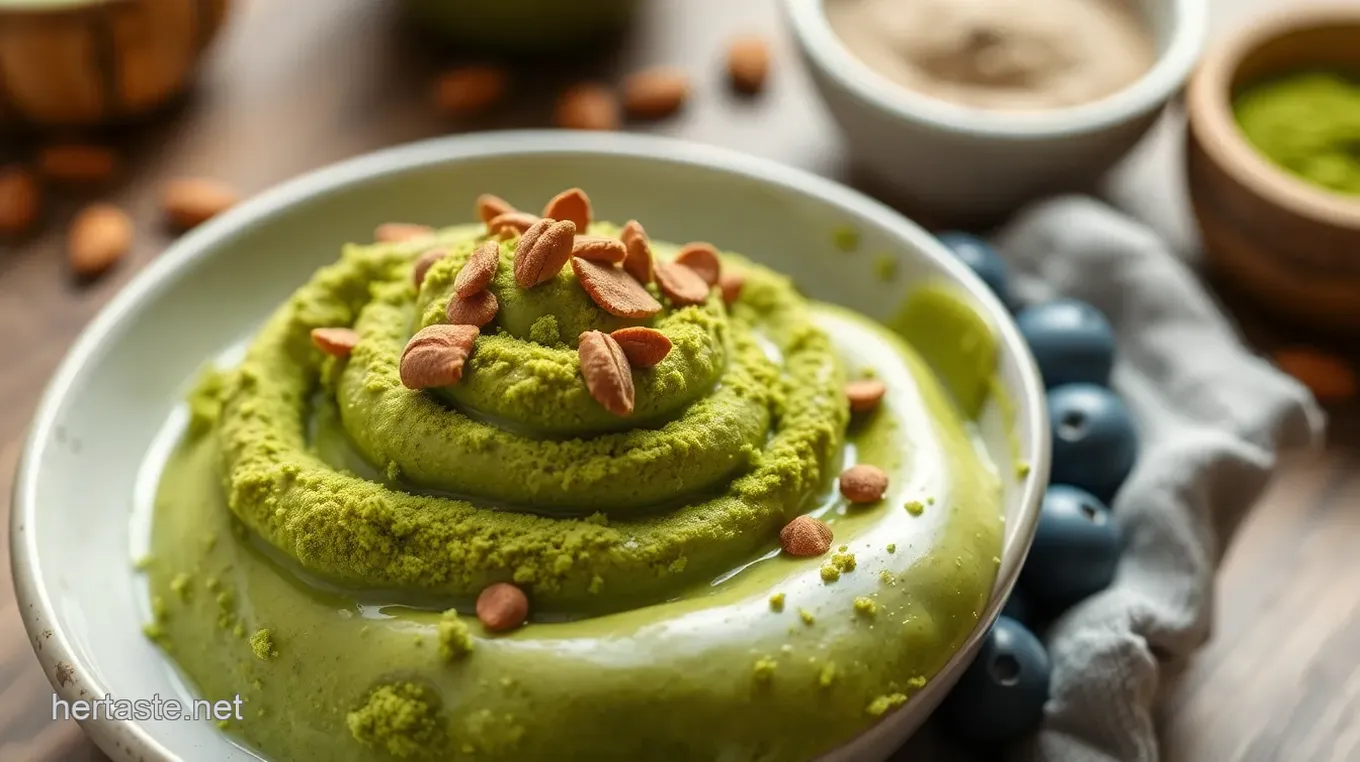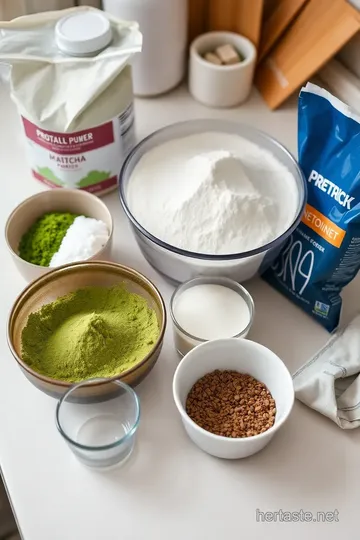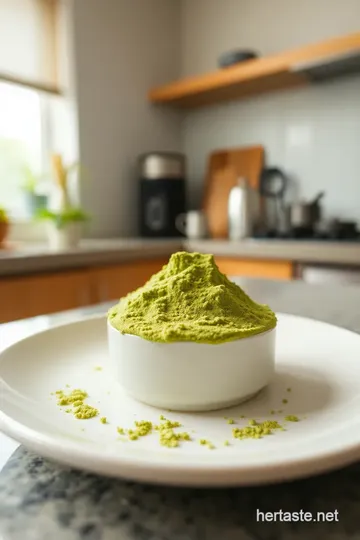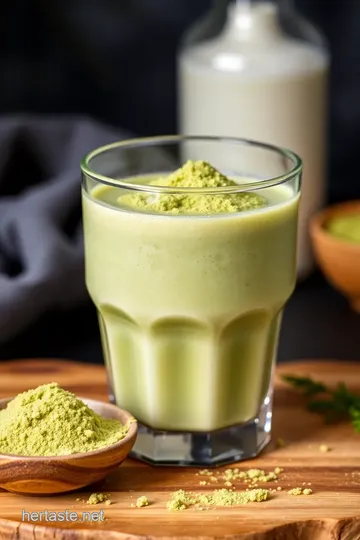Homemade Matcha Protein Powder: Energize Your Day!
Wondering how to mix matcha protein powder at home? Discover my simple and tasty recipe that will give you a vibrant energy boost filled with nutrition!

A Matcha Journey
So, picture this: it’s a chilly tuesday morning, and i’m fighting the urge to hit the snooze button for the third time.
Honestly, the struggle is real! i finally drag myself out of bed and shuffle to the kitchen, and what do i find? a bright green canister of matcha powder staring at me, like it knows i need a little kickstart.
I take a sip of my matcha latte and boom – suddenly i’m ready to tackle the world. this is when i realized how much i love to mix matcha protein powder at home .
It's not just a drink; it’s an energy boost wrapped up in a delicious experience.
Let’s dive into the world of healthy protein options and how you can elevate your game with an easy homemade blend.
With so many matcha powder benefits , you won't want to miss out. from energy-boosting snacks to flavorful smoothies, this green magic offers tons of ways to enjoy a nutritious lift in your day.
Recipe Overview
Now, what’s the deal with matcha? this green tea powder has a rich history, originating in japan over a thousand years ago.
It’s loved not just for its vibrant color but also for its health perks. nowadays, people are buzzing about it in cafes and kitchens all across america! we’re talking about a trending star in the clean eating recipes realm.
Ready to whip up your matcha protein blend in just 10 minutes ? yep, it's that easy! and the best part? it yields about ten servings .
You can throw it into smoothies, oatmeal, or even baking – the possibilities are endless! plus, whether you choose plant-based protein or whey, there’s no beating that customized nutritional protein blend you made yourself.
Key Benefits
Now let’s chat about why this is a keeper in your kitchen. first off, health benefits are a huge deal.
Matcha packs a punch with antioxidants, which can help boost your metabolism – sign me up to burn a few extra calories! pair it with protein, and you're golden.
Together, they offer a mix that supports muscle recovery and keeps you full longer.
Whether it’s early morning smoothies, post-workout snacks, or even chilled matcha shakes for a hot summer day, this vegan protein shake deserves a spot on your special occasions list.
Plus, it's way better than those store-bought versions loaded with additives and artificial flavors. why settle for less when you can take pride in crafting homemade blends that cater to your tastes?
Don’t forget – this homemade blend is all about choice. you get to play around with ingredients and adjust sweetness using natural sweeteners like coconut sugar or honey.
Get wild and toss in spices or experiment with matcha in baking . personalize it until it sings to your palate!
Transition to Ingredients
Ready to get started? Let’s lay out what you need to create this delicious, nutritious matcha protein powder . Grab those ingredients, and let’s make some magic!

Essential Ingredients Guide
Getting your kitchen stacked with the right stuff? oh my gosh , it can feel like a chore, but trust me, it’s worth your time! whether you’re whipping up that matcha protein powder at home or experimenting with new flavors, knowing the essentials makes all the difference.
So, let’s dive into the must-have elements for your next culinary adventure!
Premium Core Components
To start, let’s chat about detailed measurements . for us folks in the u.s., we’re used to cups, tablespoons, and others.
But don’t sleep on the metric system—it’s handy to know! for instance, 1 cup of flour is about 120 grams.
Accurate measurements ensure your creations turn out just right, y'know?
Next up: quality indicators . look for vibrant colors and fresh scents. for herbs like basil or parsley, fresh is fab! they should be bright, not wilted.
If they smell like yesterday’s leftovers, skip ‘em! and yep, don’t forget the storage guidelines . herbs can hang in the fridge for about a week, but dried spices? they can chill for months if kept cool and dark.
Now, let’s talk about freshness tips. when picking out ingredients, sniff your produce! yeah, seriously! it helps you avoid sad, flavorless fruits and veggies.
And always give those grains and legumes a little squeeze. if they feel off, they probably are. trust your instincts!
Signature Seasoning Blend
Okay, folks , let’s dive into seasonings! you’ll want to have an arsenal of essential spice combinations ready to rock.
Think garlic powder, paprika, and cumin—it’s like a party in your mouth! and don’t skip on herb selections —basil, rosemary, and thyme are all crowd-pleasers.
Pro tip: pair ‘em based on flavor profiles. basil loves tomatoes; rosemary shines with potatoes.
And what’s a good meal without flavor enhancers ? add a pinch of salt or a dash of lemon juice, and boom , instant pizzazz! oof, don’t get me started on regional variations! ever tried cajun spices? so good, especially in a hearty stew.
Smart Substitutions
Let’s face it; we don’t always have what we need in the pantry. that’s where smart substitutions come in! out of coconut sugar ? no sweat—substituting with brown sugar works beautifully.
Oh, and if you’re looking for dietary modifications , plant-based options are everywhere now! try a vegan protein shake if you’re going dairy-free.
And don’t panic during an emergency. if you can’t find an ingredient, think creatively! in a pinch, greek yogurt can pull off a sour cream swap.
Use that diy protein powder for a quick energy-boosting snack when you’ve got a craving.
Kitchen Equipment Essentials
What about the tools? you’ll need must-have tools like a sturdy mixing bowl and a whisk. seriously, you can survive in the kitchen with just these.
If you don’t have those fancy gadgets, don’t worry! you can always get creative with alternatives. got an old jar? use it for shaking up your homemade blends.
When it comes to preparation, make chopping enjoyable. grab a sharp knife and let loose! and don’t forget to store your kitchen utopia in ways that let everything breathe—air-tight containers for spices keep things fresh and flavorful.
The last thing you want is to grab a dusty spice from the back of the cabinet. yikes!
So now you’re prepped and ready for action. with this essential ingredients guide, incorporating matcha into your healthy breakfast ideas or mixing up your matcha energy drink just got a whole lot easier.
That’s right—let’s talk about how to mix matcha protein powder at home in the next section. trust me; you’ll love what’s coming next!
Mix and Match: Crafting Your Own Homemade Matcha Protein Powder
Oh my gosh, have you ever thought about how fun it is to whip up your own protein powder? i mean, who needs those super expensive store-bought ones when you can mix matcha protein powder at home ? trust me, it’s easier than you think, and the benefits are downright awesome! matcha is not just a beautiful green powder; it’s packed with antioxidants and can give you a boost of energy that rivals even your morning coffee.
Let’s dive into this delicious world of homemade protein blends, and i’ll share how you can create your own nutritional protein blend that’ll rock your world!
Essential Preparation Steps
Before we jump right in, let’s chat about getting organized. you know the drill— mise en place is key. lay out all your ingredients: 1 cup of protein powder, 2 tablespoons of culinary-grade matcha, and maybe a scoop of coconut sugar if you like it sweet.
It's like prepping for the big game, folks!
Now, let’s talk time management . you’ll only need about 10 minutes of active prep time. seriously, it’s a breeze.
But don’t dawdle! the sooner you start, the sooner you can enjoy that energizing shake.
What about safety considerations ? Just like you check your smoke detectors, ensure your countertop is clean. Even the best homemade protein enhancement can’t shine when there’s a sprinkle of yesterday’s leftovers!
Step-by-Step Process
Alright, here’s the fun part. We’re going to break it down into some clear steps.
-
Gather Your Ingredients : This is a no-brainer, but trust me, it's easy to miss something when you're in the zone.
-
Mix It Up : In a mixing bowl, combine your protein powder and matcha. If you’re feeling fancy, toss in a bit of coconut sugar and powdered vanilla extract.
-
Blend Thoroughly : Now get in there—whisk it until everything is nicely mixed and there aren’t any clumps. This part is super satisfying!
-
Taste and Adjust : Here’s where you get to play chef! Sample it and see if it needs more sweetness.
-
Store It Right : Transfer your blend into an airtight container. Label it if you’re the organized type. Don’t let your effort go to waste!
Expert Techniques
Let’s talk about some pro tips here. First off, always opt for high-quality culinary-grade matcha . It makes a world of difference.
When mixing, consider sifting the matcha to avoid clumps. And if you want an extra healthy protein option , feel free to add spices like cinnamon or even some cacao for a chocolatey twist!
Success Strategies
Now, before we wrap up, let’s ensure you nail this homemade matcha protein powder without a hitch. Avoid common mistakes like dumping everything in at once—nobody wants a lumpy shake!
A quick quality assurance tip : Check the expiration dates on your protein powder and matcha. You want the freshest flavors and benefits!
If you’re prepping for energy-boosting snacks , think about incorporating this powder into matcha smoothie bowls or using it in your baking endeavors. The possibilities are endless!
Final Thoughts
Crafting your own homemade protein powder not only saves you some cash but also helps you control what goes into your body.
Plus, you’re getting all the awesome matcha health benefits and can customize it to your taste. who knew healthy could taste so good?
So there you have it! Your complete guide to making delicious homemade matcha protein powder . Now, go out there, mix it up, and start enjoying your energizing creations.
As we close up here, let’s shift gears to some more additional information that’ll empower your cooking even further. Stay tuned!

Unlock the Secrets of Homemade Matcha Protein Powder
If you’re on the hunt for a nifty way to energize your day, look no further! making matcha protein powder at home is not just super simple, but it also packs a punch with matcha powder benefits .
This green goodness has roots in japan and is basically a culinary treasure trove waiting to be explored. let's dig into some pro tips, perfect presentation ideas, storage hacks, creative spins, and the nitty-gritty of nutrition.
You’ll be ready to whip up some delicious matcha energy drinks or sprinkle that vibrant goodness on your favorite dishes in no time!
Pro Tips & Secrets
Honestly, one of the best things i’ve learned going down the diy protein powder rabbit hole is to always start with high-quality matcha .
Opt for culinary-grade matcha. the flavor is brighter, and the vivid green color makes everything look fancy! and a quick tip—if you notice clumps when mixing, just sift that matcha before tossing it into your blend.
It changes the game!
For a real flavor enhancement, consider adding a dash of natural sweeteners like honey or coconut sugar. not just for shakes or smoothies, but think about putting it into your oatmeal or overnight oats too.
Those breakfast energy-boosting snacks will be next level!
Perfect Presentation
Now, let’s talk about making your matcha look as good as it tastes. when serving up your shakes or bowls, consider layering ingredients.
If you’re crafting a matcha smoothie bowl , pile on the toppings—fresh fruits, seeds, and maybe a drizzle of honey for that extra appeal.
Color combinations matter, folks; a pop of yellow banana against that lush green will make your creation shine on social media!
Storage & Make-Ahead
Wondering how to keep your homemade protein powder fresh? here’s a trick: store your matcha mix in an airtight container , tucked away somewhere cool and dark.
This little step will keep it from losing its vibrant color and flavor. speaking of freshness, plan on using your blend within a month.
After that, it still works but might lose some of its oomph.
When it comes to reheating, it’s super easy! Just mix it back into your smoothies or oatmeal straight from the container. Talk about a no-fuss breakfast.
Creative Variations
The sky's the limit when customizing your blend! want to switch it up? you might try making a chocolate matcha blend by tossing in cocoa powder.
Or if you’re feeling adventurous, throw in a little pinch of ginger or cinnamon for a spicy kick.
Remember, these blends can help you stay aligned with your dietary goals. if you're sticking to plant-based protein, simply swap in a vegan protein powder.
You can also play with spices or even seasonal flavors. pumpkin spice matcha in the fall? yes, please!
Complete Nutrition Guide
Let’s get down to the numbers. each serving of our homemade matcha protein powder packs about 20g of protein and is low in sugars.
You get all the good stuff without worrying about those nasty nutritional supplements you can’t even pronounce!
Plus, the health benefits of matcha are pretty impressive—it’s loaded with antioxidants , boosts metabolism, and helps with focus. seriously, who doesn't want a bit of that? a good way to monitor your intake is through portion guidance.
You can easily adjust servings based on your workout needs, making sure those protein levels are just where you want them.
Expert FAQ Solutions
Alright, let’s tackle some common questions. one i hear often is, "can i use this blend in baking?" absolutely! it’s perfect for creating matcha flavored recipes like pancakes or muffins.
Just remember that baking might alter some nutritional benefits, but it still brings a unique flavor!
If you're struggling with clumps in your shakes, give your protein powder a quick whirl in a blender or add a splash more liquid; sometimes, it just needs a little extra love.
Final Thoughts
So there you have it! a comprehensive guide to making, using, and enjoying your very own homemade matcha protein powder .
Get ready to jazz up your fitness smoothies and impress your friends with the most colorful, nutritious snacks out there.
Trust me, once you start mixing matcha at home, you’ll wonder how you lived without it! happy blending, friends!

Homemade Matcha Protein Powder: Energize Your Day! Card

⚖️ Ingredients:
- 1 cup (90g) vanilla or unflavored protein powder (whey or plant-based)
- 2 tablespoons (15g) culinary-grade matcha powder
- 2 tablespoons (30g) coconut sugar or sweetener of choice (optional)
- 1 teaspoon (5g) powdered vanilla extract (optional)
- An airtight container or jar for storage
🥄 Instructions:
- Step 1: Gather all ingredients and equipment.
- Step 2: In a mixing bowl, combine the protein powder and culinary-grade matcha powder.
- Step 3: If using, add coconut sugar and powdered vanilla extract.
- Step 4: Whisk or stir the mixture until all ingredients are evenly distributed, ensuring no clumps remain.
- Step 5: Sample the mix; adjust sweetness by adding more coconut sugar if desired.
- Step 6: Transfer the matcha protein powder into an airtight container and seal tightly.
- Step 7: If desired, label the container with the date and contents.
Previous Recipe: How to Cook Fluffy Ube Pancakes in 20 Minutes: A Sweet Morning Treat
Next Recipe: How to Mix Organic Umami Seasoning for Flavor Boost: 5 Easy Tips
